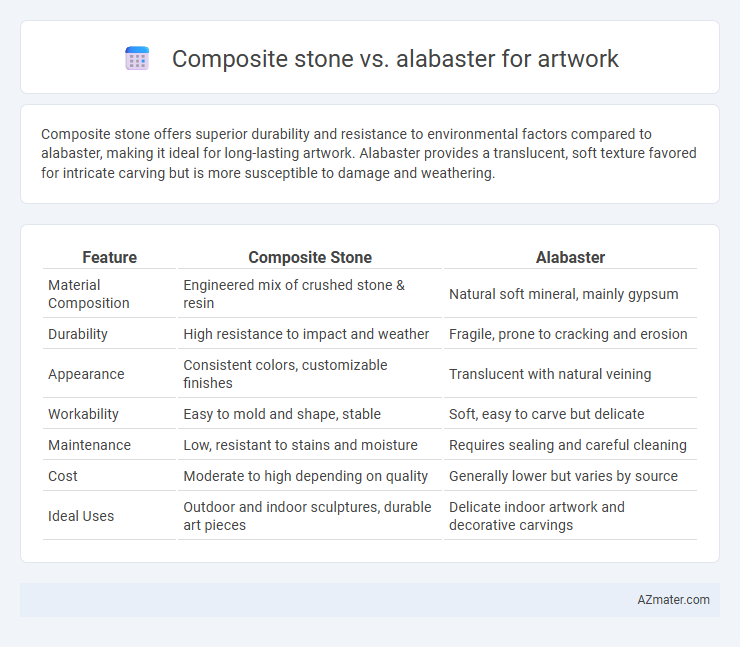Composite stone offers superior durability and resistance to environmental factors compared to alabaster, making it ideal for long-lasting artwork. Alabaster provides a translucent, soft texture favored for intricate carving but is more susceptible to damage and weathering.
Table of Comparison
| Feature | Composite Stone | Alabaster |
|---|---|---|
| Material Composition | Engineered mix of crushed stone & resin | Natural soft mineral, mainly gypsum |
| Durability | High resistance to impact and weather | Fragile, prone to cracking and erosion |
| Appearance | Consistent colors, customizable finishes | Translucent with natural veining |
| Workability | Easy to mold and shape, stable | Soft, easy to carve but delicate |
| Maintenance | Low, resistant to stains and moisture | Requires sealing and careful cleaning |
| Cost | Moderate to high depending on quality | Generally lower but varies by source |
| Ideal Uses | Outdoor and indoor sculptures, durable art pieces | Delicate indoor artwork and decorative carvings |
Understanding Composite Stone: Composition and Characteristics
Composite stone, made from a blend of crushed natural stone and resin, offers enhanced durability and versatility for artwork compared to alabaster, which is a soft, translucent mineral prone to scratching and weathering. The resin in composite stone provides resistance to moisture and UV damage, allowing for detailed carvings and outdoor installations without deterioration. Its consistent texture and color variation make composite stone a preferred choice for contemporary sculptures where longevity and stability are essential.
What is Alabaster? Origins and Properties
Alabaster is a fine-grained, translucent mineral primarily composed of gypsum, historically prized for its softness and ability to be intricately carved, originating from ancient Egypt and Mesopotamia. Its gentle, creamy texture allows artists to achieve detailed sculptures and reliefs, making it a favored material in traditional artwork. Compared to composite stone, alabaster offers a unique luminosity and warmth, though it is more porous and delicate, necessitating careful handling and preservation.
Visual Appeal: Texture and Color Comparison
Composite stone offers a uniform texture with consistent coloration, making it ideal for detailed artwork requiring smooth surfaces and precise color replication. Alabaster features a translucent quality with natural veining and subtle variations in tone, adding depth and a luminous effect that enhances sculptural pieces. The choice between composite stone and alabaster hinges on whether a controlled, polished finish or a naturally variegated, glowing aesthetic is preferred for the artwork.
Workability for Artists: Ease of Carving and Detailing
Composite stone offers artists enhanced workability due to its uniform texture and consistency, allowing for precise carving and intricate detailing with less effort. Alabaster, while softer and easier to carve initially, can be prone to chipping and requires careful handling to achieve fine details. The durability and homogeneity of composite stone make it a preferred choice for artists seeking reliable and detailed sculptural results.
Durability and Longevity in Art Installations
Composite stone offers superior durability and weather resistance compared to alabaster, making it ideal for long-lasting art installations exposed to varying environmental conditions. Alabaster, while prized for its translucency and aesthetic appeal, is softer and more prone to chipping, scratching, and erosion, particularly in outdoor or high-traffic settings. Artists and conservators often choose composite stone when longevity and structural integrity are critical for preserving artwork over decades.
Cost Comparison: Composite Stone vs Alabaster
Composite stone offers a more affordable option compared to alabaster, with prices typically ranging from $20 to $50 per square foot, while alabaster can cost between $50 and $150 per square foot due to its natural rarity and labor-intensive extraction. The cost-effectiveness of composite stone arises from its engineered materials and easier manufacturing process, making it suitable for budget-conscious art projects. Alabaster, prized for its translucent veining and natural beauty, commands a premium price that reflects its unique aesthetic and sculptural qualities.
Weight and Handling Considerations
Composite stone offers a lightweight alternative to traditional alabaster, making it easier to handle and transport for artwork projects. Alabaster, being denser and heavier, requires careful handling to prevent damage due to its fragility and weight. Artists often prefer composite stone for larger sculptures or installations where mobility and ease of handling are critical factors.
Environmental Impact and Sustainability
Composite stone offers durability and often incorporates recycled materials, reducing environmental impact compared to traditional stone. Alabaster, a natural mineral, is biodegradable but involves intensive quarrying that can lead to habitat disruption and significant carbon emissions. Choosing composite stone made with eco-friendly binders can enhance sustainability while maintaining artistic quality.
Applications in Modern and Traditional Art
Composite stone offers superior durability and versatility, making it ideal for large-scale modern sculptures and intricate traditional carvings that require longevity and resistance to weathering. Alabaster, prized for its translucent quality and softness, remains a favored medium in classical and fine art applications where detailed, delicate work and light diffusion are essential. Both materials are integral in blending contemporary techniques with historical artistic practices, enhancing visual impact and structural integrity in diverse artistic contexts.
Choosing the Right Material: Artistic and Practical Factors
Composite stone offers superior durability, resistance to weathering, and ease of maintenance, making it ideal for outdoor sculptures and high-traffic installations. Alabaster's translucent quality and fine grain provide exquisite detail and a warm glow, perfect for indoor, finely detailed artwork that emphasizes aesthetics over toughness. Artists should weigh the desired visual effect and environmental exposure, with composite stone suited for longevity and robustness, while alabaster excels in delicate, light-enhanced artistic expressions.

Infographic: Composite stone vs Alabaster for Artwork
 azmater.com
azmater.com